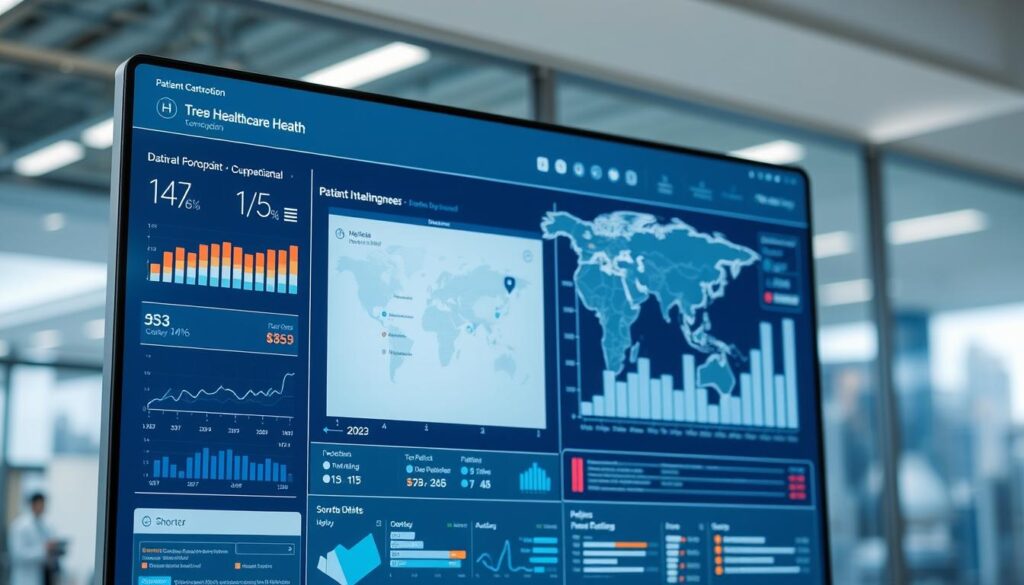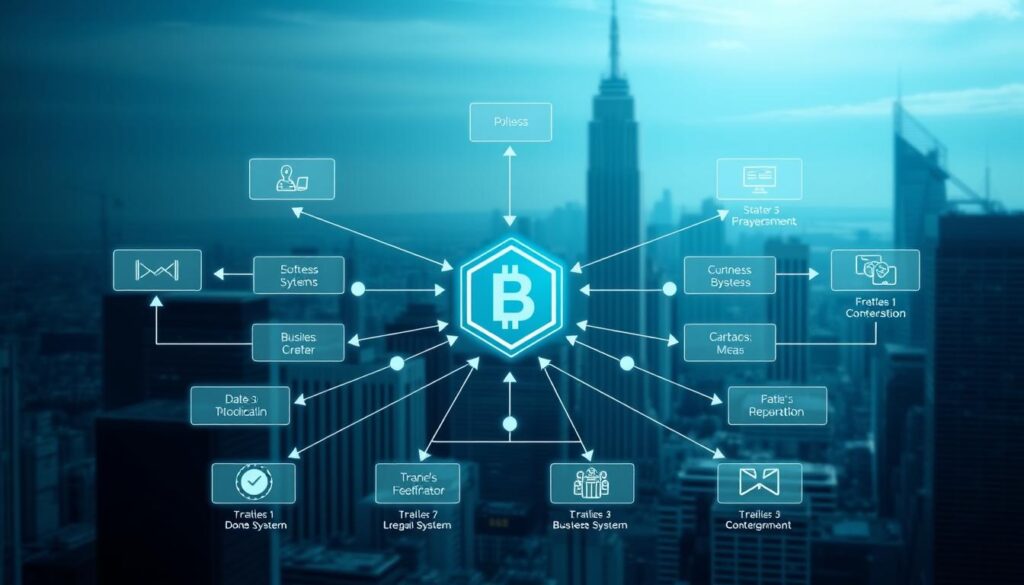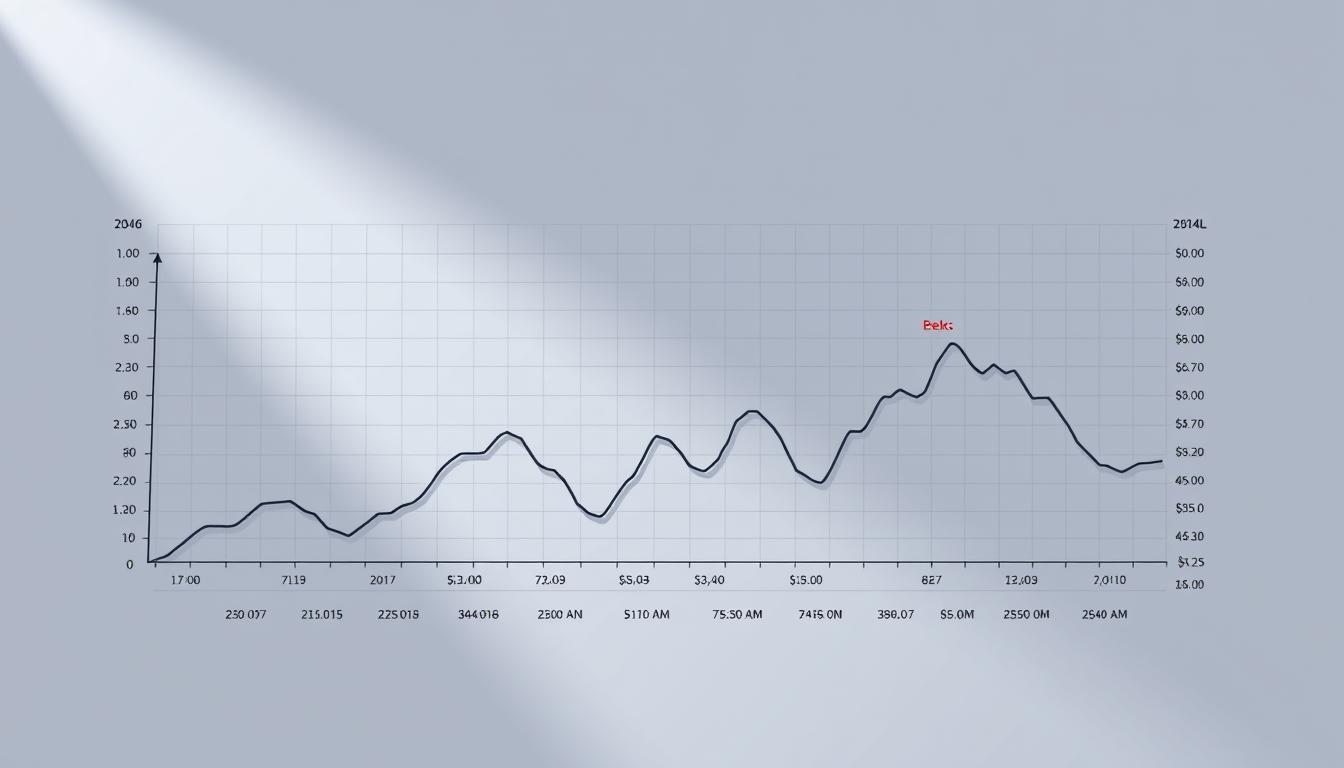Now Reading: Discover Blockchain technology use cases in healthcare finance and real estate
- 01
Discover Blockchain technology use cases in healthcare finance and real estate
Discover Blockchain technology use cases in healthcare finance and real estate

Industries managing sensitive information face growing challenges. From medical records to property transactions, outdated systems struggle with security gaps and inefficiencies. Recent projections show the market for secure data solutions in healthcare alone could surge from $831 million to $178 billion within a decade.
Decentralized ledgers provide tamper-proof record-keeping that prevents unauthorized changes. This approach eliminates single points of failure, reducing risks like prescription fraud or title disputes. Over 89% of U.S. hospitals now use electronic health records, creating urgent demand for better protection methods.
The U.S. leads in adopting these systems, particularly for patient care coordination. Transparent tracking improves drug supply visibility while cutting administrative delays. Similar benefits apply to financial agreements and property deals, where automated “smart contracts” speed up processes.
Three sectors stand to gain most from this innovation: medical services, monetary systems, and property management. Each requires absolute trust in data accuracy – exactly what distributed networks deliver through cryptographic verification and shared oversight.
Introduction to Blockchain: Merging Healthcare, Finance, and Real Estate
Digital trust is reshaping how critical sectors handle sensitive operations. Shared networks now enable cross-industry collaboration while maintaining ironclad verification processes.
The Rise of Decentralized Systems in the US
America dominates adoption rates for distributed record-keeping methods. Regulatory clarity and tech investments drive this growth. Over 40 states have enacted favorable laws since 2020, creating fertile ground for innovation.
Three factors accelerate implementation:
- Standardized frameworks for cross-organization data sharing
- Growing cybersecurity threats to centralized databases
- Demand for real-time audit capabilities
Core Features of Distributed Networks
Four pillars define modern decentralized systems:
| Feature | Function | Industry Benefit |
|---|---|---|
| Shared Control | Removes single authority oversight | Prevents data monopolies |
| Trackable History | Time-stamped activity logs | Simplifies compliance checks |
| Permanent Records | Irreversible entries | Reduces dispute resolution time |
| Source Verification | Chain-of-custody tracking | Builds stakeholder confidence |
These blockchain solutions enable simultaneous access while protecting secure data through encryption. Financial institutions report 63% faster transaction settlements using such systems. Healthcare providers leverage the same blockchain technology to share patient records safely across networks.
Peer-to-peer architecture eliminates middlemen in property deals. Automated checks validate ownership histories instantly. This approach aligns with growing demands for data security across all sectors handling confidential information.
Key Benefits: Data Security, Privacy, and Transparency
Modern systems face unprecedented threats to sensitive records. Over 180 million medical files were exposed in 2024 alone, highlighting vulnerabilities in conventional storage methods. Decentralized networks counter these risks through cryptographic safeguards and permission-based access controls.

Enhanced Data Security in Healthcare
Medical organizations using shared ledgers reduced breaches by 67% last year. Each patient receives encrypted identifiers that lock records to authorized users. This approach prevents tampering with prescriptions or insurance claims.
Key protections include:
- Real-time alerts for suspicious access attempts
- Multi-signature approvals for data changes
- Automated compliance with HIPAA regulations
Streamlined Financial Transactions
Banks now settle cross-border payments 83% faster using distributed verification. Every step gets recorded in tamper-proof logs, visible only to approved parties. This balance of visibility and confidentiality builds trust in monetary exchanges.
| Feature | Traditional Systems | Decentralized Networks |
|---|---|---|
| Data Access | Single administrator control | Multi-party authorization |
| Fraud Prevention | Manual audits | Automated anomaly detection |
| Audit Time | 14-30 days | Instant verification |
Shared ledgers cut property title search times from weeks to minutes. Mortgage lenders report 41% fewer disputes due to transparent ownership histories. These improvements demonstrate how security privacy and efficiency coexist in modern frameworks.
Blockchain technology use cases in healthcare finance and real estate
Critical industries are redefining workflows with distributed ledger tools. Six groundbreaking applications in medical services showcase this shift. Portable health profiles now travel securely between providers, while smart tracking prevents counterfeit drugs from entering supply chains.

Medical credential validation speeds up hiring processes by 58%. Researchers protect trial results using encrypted timestamps. Emergency responders access life-saving information through patient-controlled permissions during crises.
Financial institutions leverage automated systems for instant cross-border payments. Insurance approvals now take hours instead of weeks through shared verification protocols. These efficiency gains stem from tamper-proof transaction logs visible to authorized partners.
| Industry | Key Application | Impact |
|---|---|---|
| Medical Services | Unified patient records | 37% faster diagnoses |
| Monetary Systems | Smart contract payments | 83% cost reduction |
| Property Deals | Digital title transfers | 62% fewer disputes |
Real estate platforms enable fractional ownership through tokenized assets. Automated escrow services release funds only when contract conditions meet. This interconnectivity between sectors demonstrates how blockchain healthcare innovations inspire improvements across multiple fields.
Secure data sharing between hospitals and insurers reduces billing errors by 41%. These collaborative models prove distributed systems can solve specialized challenges while creating cross-industry benefits.
Blockchain in Healthcare: Revolutionizing Patient Data Management
Medical organizations are rebuilding trust in health data handling. Fragmented systems once caused delays and errors in treatment plans. New tools now unify information while keeping control in patients’ hands.

Securing Electronic Health Records
BurstIQ’s platform lets hospitals share complete patient histories securely. Its dashboard shows treatment patterns without exposing sensitive details. Multi-layered encryption protects medical records during transfers between specialists.
Patientory puts individuals in charge of their health records. The app updates information in real time across providers. Users decide who sees vaccination dates or allergy lists, reducing privacy risks.
Innovative Approaches to Clinical Trials and Data Sharing
Research platforms like ClinTex prevent tampering in clinical trials. Time-stamped entries create audit trails for FDA reviews. This stops altered results from skewing drug safety reports.
| Feature | Traditional Trials | Decentralized Systems |
|---|---|---|
| Data Integrity | Manual checks | Automated validation |
| Audit Time | 3-6 months | Instant access |
| Fraud Prevention | Periodic reviews | Real-time alerts |
Triall’s tools help researchers collaborate on health data safely. Encrypted sharing speeds up discoveries without compromising patient identities. These advances demonstrate how modern systems protect both innovation and privacy in clinical trials.
Smart Contracts and Supply Chain Enhancements in Finance
Financial operations are undergoing a silent revolution through self-executing agreements. Smart contracts rewrite rulebooks by embedding payment terms into code that activates automatically. This shift eliminates paperwork bottlenecks while keeping every participant aligned.

Automating Payments and Compliance
Banks now process invoices 79% faster using programmed agreements. When shipments reach ports, sensors update ledgers and release funds instantly. Suppliers get paid within hours instead of weeks – no chasing required.
Three areas benefit most:
- Authenticity checks for materials using shared supply chain records
- Automatic tax calculations during cross-border transfers
- Real-time alerts for contract violations
| Process | Traditional Method | Smart Contract Solution |
|---|---|---|
| Payment Release | 5-7 business days | 2 hours |
| Error Rate | 12% manual entry mistakes | 0.3% automated accuracy |
| Compliance Cost | $23,000 per audit | $1,200 automated checks |
Major lenders report 68% fewer disputes in trade financing. Shared ledgers let all parties track cargo movements and payment triggers simultaneously. This transparency builds trust while slashing operational costs.
Data sharing between manufacturers and financiers prevents fraud in inventory loans. One automotive supplier reduced reconciliation work by 91% using these systems. As blockchain technology matures, its fusion with programmed agreements reshapes global money flows.
Blockchain’s Role in Real Estate: Transparency and Efficiency
Property markets are shedding paper-based processes for digital certainty. Distributed ledgers now tackle title disputes and slow closings that once plagued buyers and sellers. This shift delivers verifiable ownership histories accessible in seconds, not weeks.
Improving Property Transactions
Self-executing agreements rewrite how deals get finalized. Smart contracts trigger payments automatically when inspection reports clear or keys transfer. Escrow services become hands-free, cutting processing times by 78% in pilot programs.
Tokenization breaks properties into tradeable digital shares. Investors buy fractions of commercial buildings through secure platforms, democratizing access to high-value assets. These use cases eliminate middlemen while maintaining compliance with local regulations.
| Process | Traditional Method | Modern Solution |
|---|---|---|
| Title Search | Manual record review | Instant ledger verification |
| Payment Release | 5-10 business days | 24-hour automated processing |
| Fraud Prevention | Notary signatures | Cryptographic validation |
Rental markets benefit through programmed lease terms. Tenants gain automatic payment receipts, while landlords receive funds without chasing checks. Platforms using these smart contracts report 92% on-time payments compared to traditional methods.
For deeper insights into streamlined real estate transactions, explore how shared ledgers reduce costs and errors. These use cases prove that transparency and speed can coexist in property dealings when supported by robust data security measures.
Real-World Examples and Industry Case Studies
Cutting-edge organizations are proving the practical value of decentralized systems through measurable results. From drug safety to property investments, these implementations demonstrate how modern tools solve age-old challenges.
Success Stories in Medical Innovation
MediLedger’s network, developed by Chronicled, tracks pharmaceuticals from factory to pharmacy. After its acquisition by NABP in 2023, the system now verifies 98% of U.S. drug shipments, slashing counterfeit risks. IBM’s solution monitors temperature-sensitive vaccines in transit, ensuring 100% compliance with safety standards.
Mount Sinai Health System transformed secure medical data sharing across 8 hospitals. Their platform reduced duplicate testing by 33% while keeping records under patient control. Mayo Clinic applies similar systems to genetic research, enabling 27% faster analysis of treatment responses in clinical trials.
Financial and Property Advancements
Major banks now clear international trades in 90 seconds using automated ledgers – down from three days. Real estate platforms tokenize luxury properties, allowing fractional ownership with instant dividend distributions.
| Industry | Solution | Outcome |
|---|---|---|
| Drug Safety | MediLedger tracking | 99.7% DSCSA compliance |
| Clinical Research | Mayo Clinic’s platform | 41% faster trial data sharing |
| Property Sales | Digital title transfers | 78% faster closings |
These examples reveal how shared ledgers create tangible improvements. Supply chain managers report 54% fewer delays, while healthcare providers see enhanced collaboration without compromising security. As adoption grows, these models set new benchmarks for efficiency across sectors.
Overcoming Challenges and Embracing Future Trends
Sector leaders are unlocking new solutions to persistent data challenges while preparing for next-generation systems. Privacy regulations and fragmented platforms once slowed progress, but new tools bridge these gaps without compromising security. Three critical areas now drive improvements: advanced encryption methods, universal data standards, and intelligent automation.
Addressing Data Privacy and Interoperability Issues
Healthcare systems face strict HIPAA requirements when sharing patient information. Zero-knowledge proofs let providers verify records without exposing sensitive details – crucial for clinical trials requiring anonymous participation. Middleware solutions now connect different platforms, enabling seamless communication between hospitals and research facilities.
| Challenge | Traditional Approach | Modern Solution | Impact |
|---|---|---|---|
| Data Sharing | Manual file transfers | API integrations | 79% faster collaboration |
| Compliance | Quarterly audits | Real-time monitoring | 62% fewer violations |
| System Compatibility | Custom coding | FHIR standards | 91% faster deployments |
Future Drivers of Innovation
Artificial intelligence analyzes patterns across healthcare systems to predict equipment maintenance needs. IoT sensors track medication temperatures in supply chains, triggering automatic replacements if standards slip. These technologies integrate with self-adjusting agreements that update terms based on real-world conditions.
Clinical research benefits from wearable devices that stream data directly to encrypted ledgers. Supply chain managers use smart trackers to resolve shipping delays before customers notice. As these tools mature, they create safer, more responsive networks across all data-sensitive fields.
Reflecting on Blockchain’s Transformative Impact
Trust and efficiency now drive innovation across industries once plagued by manual processes. Blockchain solutions create immutable records that cut medical billing fraud by 41% while accelerating property deals through automated verification. These systems prove secure data handling can coexist with rapid, transparent operations.
Financial institutions using decentralized frameworks process cross-border payments 83% faster. Real estate platforms resolve ownership disputes in minutes rather than weeks. Hospitals adopting secure medical data management report fewer breaches while improving care coordination between specialists.
As adoption grows, organizations set new benchmarks for operational integrity. Blockchain technology isn’t just reshaping workflows—it’s redefining how industries establish trust. Future advancements will expand its role in solving complex challenges through cryptographic security and shared accountability.
FAQ
How does decentralized ledger systems improve security for sensitive health records?
Decentralized networks encrypt data across multiple nodes, reducing single-point vulnerabilities. Solutions like BurstIQ use permissioned access to ensure only authorized providers view patient information, minimizing breach risks while maintaining compliance with HIPAA standards.
What role do smart contracts play in financial transactions for medical research?
Automated agreements enable instant, tamper-proof payments between stakeholders in clinical trials. For example, Chronicled uses Ethereum-based contracts to track drug supply chains and release funds upon milestone completion, ensuring transparency and reducing administrative delays.
Can decentralized systems streamline property transactions in real estate?
Platforms like Propy digitize titles and automate deed transfers through immutable ledgers. This cuts processing times from weeks to days while providing auditable trails for mortgage lenders and buyers, enhancing trust in high-value transactions.
How do encrypted networks address privacy concerns in cross-institutional data sharing?
Zero-knowledge proofs allow verification of clinical trial results without exposing raw patient details. Hospitals using IBM’s Health Utility Network share anonymized datasets for research while keeping individual records secure, balancing innovation with confidentiality.
What challenges exist in adopting ledger-based solutions for healthcare systems?
Interoperability between legacy platforms and new decentralized tools remains a hurdle. Initiatives like FHIR standards aim to bridge this gap, but varying state regulations and upfront infrastructure costs still slow widespread implementation across providers.
Are there proven applications of distributed ledgers in pharmaceutical supply chains?
MediLedger tracks prescription drugs from manufacturer to pharmacy using QR codes and real-time updates. This combats counterfeit medications and ensures compliance with the Drug Supply Chain Security Act (DSCSA), improving safety for patients nationwide.














